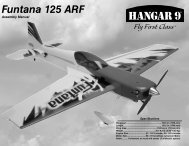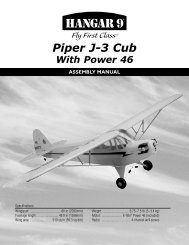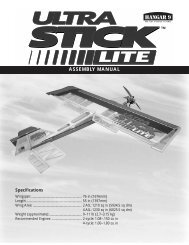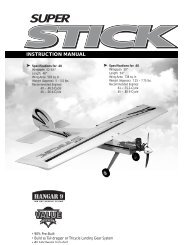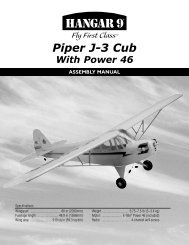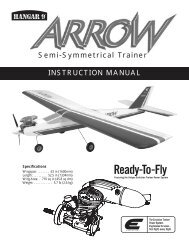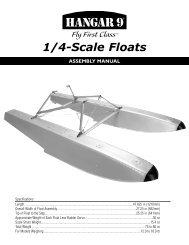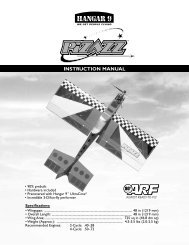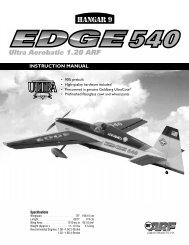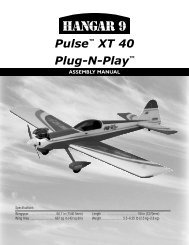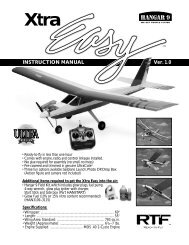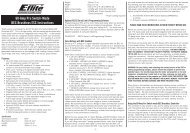ASSEMBLY MANUAL B-25 Mitchell ARF - RC DEPOT
ASSEMBLY MANUAL B-25 Mitchell ARF - RC DEPOT
ASSEMBLY MANUAL B-25 Mitchell ARF - RC DEPOT
You also want an ePaper? Increase the reach of your titles
YUMPU automatically turns print PDFs into web optimized ePapers that Google loves.
Pre-FlightCharge both the transmitter and receiver pack for yourairplane. Use the recommended charger supplied withyour particular radio system, following the instructionsprovided with the radio. In most cases, the radio shouldbe charged the night before going out flying.Engine Run-In InstructionsThe importance of having both engines run through theentire flight is typically the most important aspect of flyinga twin engine model. We strongly recommend followingthese pre flight engine break-in and tuning instructions.1) Before you attempt to fly your B-<strong>25</strong> <strong>Mitchell</strong>we suggest that you do a proper and thoroughbreak-in of your engines. Start by removing thefiberglass cowls to allow easy adjustment of theengine carburetors. We suggest running 1–2 tanksof fuel through each engine separately followingthe engine manufacturer's break-in procedure. Itis important that the engines each have a reliableidle and a smooth transition thru the mid rangeup to full throttle. Adjust the low & high speedneedles as necessary following the instructionsthat came with your engine.2) When you are satisfied with the idle and thetransition from idle to full throttle of both enginesyou are now ready to start and run both enginessimultaneously. Start both engines and let themidle for a few seconds allowing the idle to stabilizeon both engines. Using a tachometer to check therpm of both engines is recommended.Check the radio installation and make sure all thecontrol surfaces are moving correctly (i.e. the correctdirection and with the recommended throws). Test runthe engine and make sure it transitions smoothly fromidle to full throttle and back. Also ensure the engine istuned according to the manufacturer’s instructions,and it will run consistently and constantly at full throttlewhen adjusted.Check all the control horns, servo horns and clevises tomake sure they are secure and in good condition. Replaceany items that would be considered questionable. Failureof any of these components in flight would mean the lossof your aircraft.The two engines should have rpm readingswithin a couple hundred rpm of each other,but not necessarily identical. Do not changeany of your low speed needle settings to tryand obtain identical idle rpm readings for bothengines. Advance the engines to full throttlepaying attention to the transition. Both enginesshould transition in a similar pattern and oncethey reach full throttle should have the same orsimilar Rpm reading. Again both engines shouldbe within a couple hundred Rpm of each other.If the rpm readings are not with in a couple ofhundred rpm, then do not try to lean or richenthe high speed needle. We would recommendthat you either electronically or mechanicallyadjust the throttle linkage to bring the higherrpm engine down to match the other engine.The majority of your flight will take place withthe engines at or near half power.3) Once you are satisfied with the idle, transition,and full powers settings of your engine you needto replace the cowls and again run the engines.A fully cowled engine can run at a highertemperature than an un-cowled engine so it isimportant to again check these parameters withthe engine cowls installed. Remember that it isbetter to run the engines slightly rich for bettercooling. Never run the engines at peak rpm, butrather a couple hundred rpm below maximum.75



